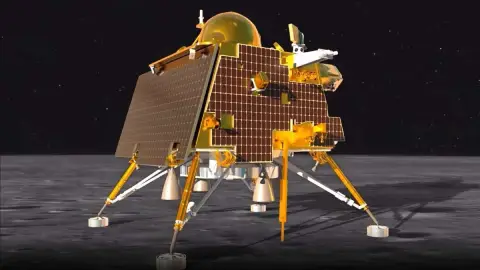India’s Triumph in Lunar Exploration, A Historic Soft Landing on the Moon’s South Pole by Chandrayaan-3 Sparks National Pride, Showcasing Technological Excellence, Cultural Resonance, and Collective Achievement.
Introduction
In a monumental achievement, the Indian Space Research Organisation (ISRO) has solidified India’s position as a global space power by successfully executing a soft landing on the Moon’s surface with the Chandrayaan-3 spacecraft. This historic milestone was attained on a Wednesday evening (23rd Aug 6:04 pm IST), marking India as the first nation to land a spacecraft on the uncharted terrain of the lunar south pole. Moreover, this accomplishment positions India as the fourth country overall to achieve a lunar landing.
The Vikram lander, a critical component of the Chandrayaan-3 mission, elegantly executed its soft landing at precisely 6:04 PM (Indian Standard Time). This triumphant event comes after the Chandrayaan-2 mission faced disappointment with a crash-landing four years prior. Commending the team of dedicated scientists behind this mission, ISRO’s Chief, S Somnath, conveyed that the condition of the lander would undergo assessment, following which the rover is slated to disembark from the lander module within the upcoming hours.
ISRO has articulated three primary objectives for the Chandrayaan-3 mission. First, it aims to demonstrate a secure and gentle landing on the lunar surface, thus showcasing technological prowess in precision landings. Second, the mission endeavors to showcase the mobility of a Rover on the Moon’s surface, further exemplifying India’s strides in space exploration. Thirdly, the Chandrayaan-3 mission will conduct on-site scientific experiments, providing invaluable insights into the Moon’s composition and characteristics.

As India garners accolades for achieving significant milestones within limited budgets, C Raja Mohan asserts that the time has come for the Indian space program to transcend frugal innovation and aspire to greater global lunar endeavors. This success on the lunar surface has catapulted India onto the world stage, necessitating a more expansive and ambitious approach to lunar exploration.
In the wake of this remarkable feat, Nalini Singh has offered a poignant plea to political figures. She implores them to refrain from seeking credit through live television broadcasts or condescendingly patting the back of ISRO’s chairman. This is a time for collective celebration of a scientific accomplishment that transcends political boundaries and affiliations.
Turning our gaze to the cultural significance of the Moon, Devdutt Pattanaik delves into the celestial body’s role in Indian mythology. Drawing from a rich tapestry of myths, stories, and legends, Pattanaik uncovers the Moon’s cultural resonance within the Indian identity. These narratives contribute to the broader understanding of the celestial body, intertwining science and spirituality.
Looking forward, India’s achievement in lunar exploration demonstrates the nation’s increasing prominence in the global space community. This successful mission serves as a harbinger of more ambitious space endeavors to come. With an eye towards the future, ISRO’s accomplishments underscore the importance of sustained investment in space research and exploration.
Conclusion
The Chandrayaan-3 mission’s soft landing on the Moon’s south pole is a watershed moment for India’s space program. The successful execution of this mission not only solidifies India’s position as a significant player in the realm of space exploration but also paves the way for future lunar endeavors. As India takes its place among the elite group of nations that have achieved lunar landings, the country’s scientific community, cultural heritage, and technological prowess stand united in celebration of this monumental achievement.







